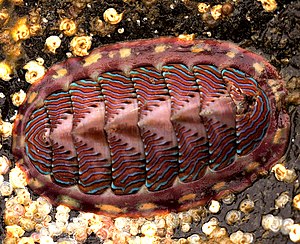Beetle snails
| Beetle snails | ||||||||||||
|---|---|---|---|---|---|---|---|---|---|---|---|---|

Tonicella lineata |
||||||||||||
| Systematics | ||||||||||||
|
||||||||||||
| Scientific name | ||||||||||||
| Polyplacophora | ||||||||||||
| de Blainville , 1816 | ||||||||||||
| Subclasses | ||||||||||||
|
The beetle snails (Polyplacophora) represent a group of mollusks or the subgroup of the spiny mollusks . The approximately 900 species of the beetle snails live exclusively in the sea , especially in the area around Australia . They reach heights of 0.5 to 45 centimeters and are crepuscular. The age of the mollusc group is estimated to be 500 million years.
features
The main characteristic of the Polyplacophora is its shell , which in today's forms consists of eight individual plates and covers the top of the animal. In fossil forms, up to 17 individual plates are known ( multi-plate = Multiplacophora). The characteristic shell plates are movably connected to one another and are framed in their entirety by a belt ( perinotum ). Lime needles, flakes of lime or lime bodies are embedded in the belt. The plates cover the head and the creeping foot of the animals, which is only separated from the head by a furrow . A mantle channel with up to 88 pairs of gills surrounds the head and foot. The dorsal , upper, pigmented skin layer made of organic material is called the tegmentum. The plate is covered by hundreds of tiny crystal ( aragonite ) lenses under which light-sensitive cells are hidden. With this, the animals can presumably locate the outlines of their enemies. Aragonite has two focal lengths, which means that the animals can see clearly under water as well as on the surface of the sea.
Way of life
Beetle snails mainly eat vegetal and animal substrate growth - algae , bog animals , hydrozoans and barnacles (Balanidae). The mouth opening with the very large radula (rasp tongue) lies directly in front of the animals' creeper. The rasp tongue can reach a length of up to a third of the body length and is sometimes equipped with more than 40 transverse rows of teeth hardened by magnetite . However, some species also feed predatory on small crabs and occur at depths of up to 5000 m. The animals lurk for prey by lifting the front part of the body or the belt from the ground. Small tentacle-like appendages on the front edge of the mantle function as tactile organs. If a prey comes into contact with the tentacles, the belt folds to the ground and buries the prey under itself. The prey can then be eaten in peace.
Most beetle snails are segregated and the gametes (sperm and eggs) are simply released into the water. Internal fertilization only takes place in a few species . Some species even practice a primitive form of brood care in their mantle trough.
Systematics of the beetle snails
The following classification follows Parker:
- Class Polyplacophora
- Subclass Neoloricata
- Order Lepidopleurida
- Family Hanleyidae
- Family Choriplacidae
- Family Lepidopleuridae
- Order Ischnochitonida
- Family Subterenochitonidae
- Family Ischnochitonidae
- Schizoplacidae family
- Family Callochitonidae
- Callistoplacidae family
- Family Chaetopleuridae
- Family Mopaliidae
- Family Schizochitonidae
- Family Chitonidae
- Genus Chiton
- Order Acanthochitonida
- Acanthochitonidae family
- Order Lepidopleurida
- † Subclass Palaeoloricata
- † Family Mattheviidae
- † Family Chelodidae
- † Family Septemchitonidae
- † Family Preacanthochitonidae
- † Gotlandochitonidae family
- † Family Scanochitonidae
- † Subclass Multiplacophora
- Subclass Neoloricata
Individual evidence
- ↑ Willy Kükenthal, Maximilian Renner: Guide for the zoological internship. 17th edition. Gustav Fischer, Jena 1978. ISBN 3-437-20172-7
- ↑ Crystal eyes. In: Der Spiegel. Hamburg 2011, 16, p. 116. ISSN 0038-7452
- ↑ Chitonidae . In: worldwideconchology.com.
Web links
- Learning from beetle snails. Tiny mollusc teeth as a model for customized crystals . In: Wissenschaft.de.

